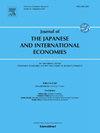The effect of public-sponsored job training in Japan
IF 3.1
3区 经济学
Q1 ECONOMICS
Journal of the Japanese and International Economies
Pub Date : 2022-06-01
DOI:10.1016/j.jjie.2021.101187
引用次数: 2
Abstract
This study investigates the short-term effects of public-sponsored job training (PJT) for the unemployed on their subsequent working status and income using a large-scale Japanese government survey and the propensity score matching technique. We find a significantly positive effect on the probability of working for both men and women; however, the point estimate is larger for women than for men. We also find a gendered difference in the effects on income and probability of being employed as a regular worker, with significantly positive effects for women but no significant effects for men, suggesting that PJT might be more effective for women. We confirm that the results are robust to a range of empirical specifications.
日本公共职业培训的效果
本研究采用大规模日本政府调查和倾向得分匹配技术,考察了公共职业培训(PJT)对失业人员后续工作状态和收入的短期影响。我们发现,男性和女性的工作概率都有显著的正影响;然而,女性的点估计值比男性大。我们还发现,性别差异对收入和成为正式员工的可能性的影响,对女性有显著的积极影响,但对男性没有显著影响,这表明PJT可能对女性更有效。我们确认,结果是稳健的一系列经验规范。
本文章由计算机程序翻译,如有差异,请以英文原文为准。
求助全文
约1分钟内获得全文
求助全文
来源期刊
CiteScore
5.10
自引率
6.90%
发文量
36
期刊介绍:
The Journal of the Japanese and International Economies publishes original reports of research devoted to academic analyses of the Japanese economy and its interdependence on other national economies. The Journal also features articles that present related theoretical, empirical, and comparative analyses with their policy implications. Book reviews are also published.

 求助内容:
求助内容: 应助结果提醒方式:
应助结果提醒方式:


